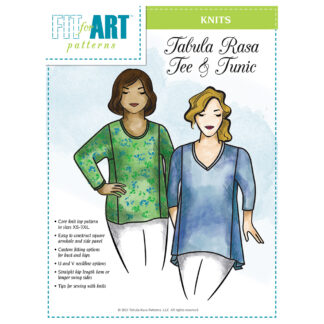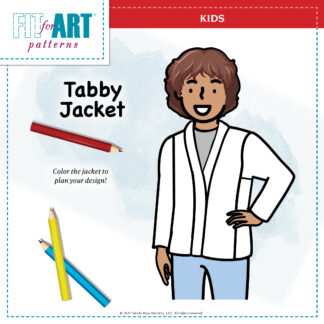
One of the last steps in completing a Tabula Rasa French jacket is to apply the trim. I love the way trim personalizes the jacket; trims can keep the jacket conservative and predictable, dress it up, provide an artful edge, or give it a fanciful finish. Whichever direction you choose for your trim, it should have enough texture to stand out on the very textured bouclé.

I love the process of choosing the trim. Since most of the trims I have used have been stacked (meaning I applied one trim on top of another), the process of choosing has taken some time. When you are shopping for trim, try to have a large enough piece of fabric to get a real sense of the trim’s effect. Look at your choices both up close and from a distance before you make your choice.
Knowing what trim you will use can also affect the order of construction. For instance, if you are planning to insert the fabric’s selvage into your hems and edges, that must be done before the jacket’s other finishes. In addition, cut the continuous selvage away from the fabric before you begin to lay your pattern pieces out on the bouclé.
Purchase plenty of trim. For my raspberry jacket I had purchased 3 yards of each trim thinking I would have plenty. By the time I got to the trim and measured my edges, including the extra needed to shape the trim around the neck curve, I was a little bit short. I had to shorten the sleeve vent about an inch on each side so I would have enough.

This jacket’s trim consists of a novelty ribbon in raspberry and orange and a beaded trim built on brown net. Since I did not have any extra trim to make a sample, I decorated a pocket first. I measured and cut the ribbon long enough to turn each end under by 1/8”. After carefully pinning the ribbon in place, I tacked it down the center. With extra care, I secured each turned-under end; if you are using trim that frays, put clear fabric glue along the cut edge to prevent additional unraveling.

The beaded net had a bit of stretch so I measured the trim, stretching it a bit and adding ¼” to the measured length for a longer turn under. I wrapped a piece of tape around the trim and cut through the middle of the tape so the beads would not drop off. The net was very wide, so I trimmed it to ¼”all around and removed the beads on each end to allow for a flat turn under.

I kept the extra beads in a small container. A marble cork lined coaster is a great place to keep beads when you are working on a project because it is heavy enough so that it won’t easily be knocked over.
I stitched the beaded trim along one long edge from the back with the beads face down on the pocket edge. This allowed me to make a pretty accurate placement. Then I flipped the trim and finished the other three edges from the front.

Pleased with the results on the first pocket, I used this method of application to finish the other pocket, neck and front edges, and the sleeve hems and vents.

I am delighted with how it looks. The beads give the jacket a little sparkle and the ribbon underneath really sets off the trim. I had considered using a gold chain to set off the ribbon for a more casual look but I was afraid it would make the jacket heavy. And frankly, I did not think it was really my style. Another blogger using this same fabric made a different choice of trim; see what you think. The trim really does establish the coat’s personality!

In the first French jacket blog post are pictures of other jackets. Take a look at and the trim’s effect on each jacket. The single wide purchased trim on the white jacket was quick and easy to apply. The trim on the gray jacket was handcrafted from sequined velvet ribbon, feathers and threads pulled from the fabric. The trim was built on the jacket before the lining was finished and it took me several weeks to complete. Check out other trim possibilities I have collected on my Pinterest page for French jackets.
Have you made a French jacket or seen one with particularly perfect or original trim? What materials were used for the trim? What are your favorite sources for trim? We’d love for you to share your ideas with everyone in the Fit for Art community.
Now that this jacket is finished, I am planning another one. I have a beautiful piece of bouclé that features pink, blue and tan hounds tooth on a black background. Now I just have to find the right trim…
Happy Sewing, RAE







The jacket is beautiful. Have a piece of boucle and can not wait to try it with this pattern. I would love to see a picture of you in the jacket!
Kendra, Watch the Fit for Art facebook page, we will try to get one up for you to see. RAE
I’m trying to figure out how to measure how much trim I will need for some blazers I’m working with. What is the method for measuring around the lapels, collar, sleeves, etc, to get an accurate idea of how much trim to buy? Thanks!
I usually use a tape measure and measure generously. Remember that each place the trim is cut or mitered it will need to be turned under for a clean finish and this can add up. I often think I have enough and then have to cheat a little on the sleeve placket. I work on my cutting table, scrap paper and pencil in hand, record each measurement, double those like the sleeve that you need two sets of lengths, then take a total. Good luck.
I am currently weaving a channel style fabric and would like to add the lining quilting as the channel jacket is done. I am wondering if you have provided information on lining the Tabula Rasa jacket.
If you read the previous posts in that series, http://fitforartpatterns.com/helpful-hints/sew-lets-get-dressed-french-jacket-tools-and-tricks/
and http://fitforartpatterns.com/helpful-hints/sew-lets-get-dressed-managing-the-french-jacket-handwork/ you can read about quilting the lining to each jacket piece before construction and then finishing all the lining seams by hand. That is the traditional way to do it. You can read all the posts if you search the French Jackets tab in Sew! Let’s get Dressed blog archive.
Doing a simple jacket lining is included in the Tabula Rasa Jacket Directions booklet if you do not want to do the traditional hand stitched, quilted lining.